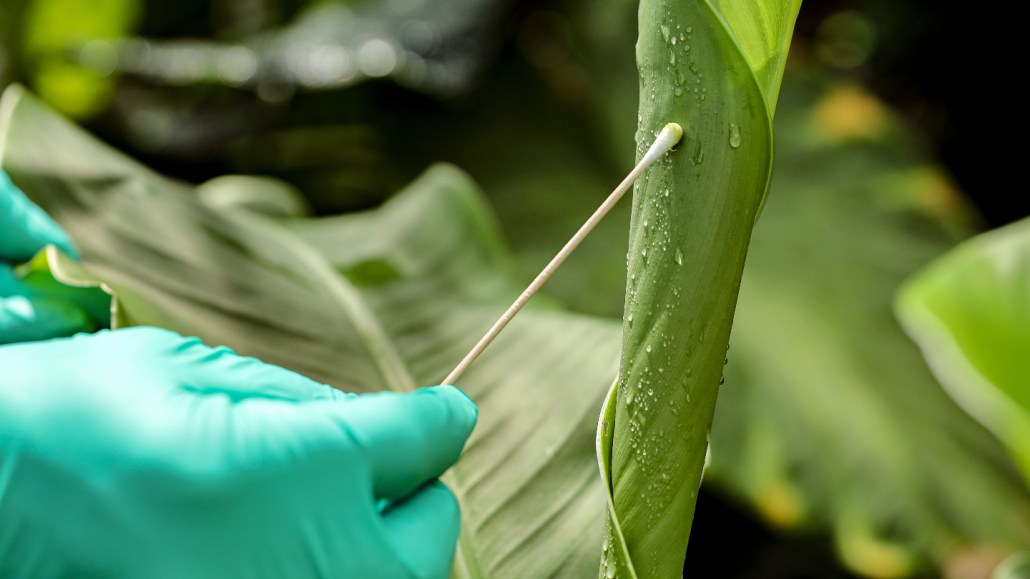
Swabs from two dozen leaves in Uganda’s Kibale National Park let researchers genetically identify 52 animals in the forest.
Andreas Sachse
- More than 2 years ago
Just a few swabs from a handful of leaves can say a lot about what animals are roaming in the area.
Two dozen leaf swabs from plants in Uganda’s Kibale National Park revealed a stunningly accurate genetic picture of the park’s vertebrate diversity, researchers report in the Aug. 21 Current Biology. The swabs picked up environmental DNA, or eDNA, shed from 52 animals, 30 of which could be identified to the species level. The quick and easy technique is a potentially revolutionary way to monitor biodiversity.
“The fact that they could just swab a few leaves like that and get that many species is really kind of cool and remarkable,” says Julie Lockwood, a biologist at Rutgers University in New Brunswick, N.J., who was not involved with the study.
While we often picture DNA sitting safe and snug inside of cells, the truth is that particles of the genetic material are loose all over the environment. This eDNA often collects in “pools” in bodies of water or on surfaces like tree bark. Finding and analyzing eDNA can reveal what species are in an area — even those that are hard to spot.
Jan Gogarten, a biologist at the University of Greifswald in Germany, wanted to compare his eDNA source — flies that pick up DNA from dead animals and feces — with that of biologist Christina Lynggaard, who collects eDNA from the air (SN: 1/18/22). The two set out to compare their respective techniques in Kibale, but setting up the necessary air filters was time-consuming, so after collecting his flies, Gogarten decided to swab some nearby leaves while he waited.
“It was not something that we had planned before,” says Lynggaard, of the University of Copenhagen.
All the swabbing in the study, done across three areas of the park, took 72 minutes in total—an average of three minutes per swab. For comparison, Lynggaard ran air filters to collect eDNA for a minimum of 30 minutes each in a prior study, not including time to set up and clean the apparatus. The researchers then brought the swabs back to Denmark for analysis.
The eDNA turned up many charismatic birds and mammals that are known to live in the park, including the great blue turaco (Corythaeola cristata) and the African bush elephant (Loxodonta africana), but there were a few surprises too.
Colin Chapman, another collaborator on the project and a biologist at Vancouver Island University in Nanaimo, Canada, “has been working in the forest for 30-something years,” Gogarten says, “and he had bird species on the list that he hadn’t seen before,” but have been spotted in the park by others. “There’s a lot out there that we just don’t see” that can be revealed with eDNA.
What’s more, the swabs are more convenient to travel with compared with other sampling devices. Lockwood, for example, samples eDNA from plant surfaces using paint rollers. With the smaller swabs, she says, “you can just use established forensic techniques to save the swabs and get them out of the field and take them back to the lab.”
With biodiversity declining in many areas around the globe, sampling eDNA using techniques like leaf swabs “allows us a revolutionary step forward in our ability to document those changes and respond to them,” Lockwood says (SN: 9/4/20). “There’s not one tool for gathering the eDNA and processing everything that works in every case. So the more tools we have, the better off we are.”
Gogarten and Lynggaard hope that others will take their swabbing technique and run with it. Because the method “can be used by nonscientists,” Lynggaard says, “people interested in citizen science could … help researchers fight this biodiversity loss that we’re having worldwide.”
For example, schoolchildren armed with swabs, Gogarten says, could sample leaves in their backyards and produce a picture of their own area’s biodiversity.





